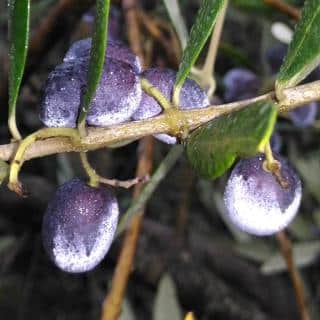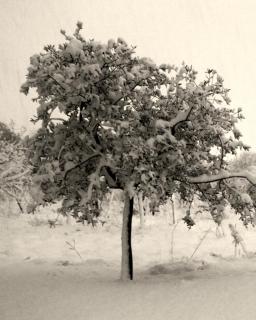

Oh, the joy of growing an olive tree! Even though olive is associated to warm Mediterranean weather, freezing cold also plays a crucial part in olive bearing.
Let’s check how low temperatures influence olive trees, especially freezing. Learn how to harden your olive tree.
Read also:
It has been said time and time again that the Olive tree is a hardy fruit tree. However, it does have limits, and those who ignore them might be in for an unpleasant surprise.
Here is a table that shows how olive trees suffer in case of low temperature (numbers for the hardier ‘Arbequina’ variety, mostly):
| Temperature °F | Event or Damage | Temperature °C |
| Temperature °F | Dormancy & flower formation triggered | 12.5°C |
| 45°F | Optimal temperature for dormancy | 7°C |
| 39° to 70°F | Flower formation occurs | 4°C to 21°C |
| 30° to 39°F | Flower formation impaired | -1°C to 4°C |
| Above 23°F | No damage | Above -5°C |
| 19° to 23°F | Micro-cracks in bark, leaf tip burn | -5° to -7°C |
| 14° to 19°F | Leaf burn, older leaves fall | -7° to -10°C |
| 10°F | Leaf drop, all leaves are killed | -12°C |
| 9°F | Leaf buds, flower buds are killed | -13°C |
| 7°F | Twig burn, bark splits, damage | -14°C |
| 5°F | Twig death, wood splits, limb dieback | -15°C |
| 1° to -7°F | Large olive tree killed by freezing | -17°to -22°C |
This is for when other conditions are the best possible. Olive tree hardiness isn’t good whenever the following happens:
The numbers above are mostly based on the Arbequina variety, which is hardier. Similarly hardy is the French Picholine variety. Most other varieties are more vulnerable.
It’s possible to reduce damage by freezing to olive trees by winterizing them. Another solution if your area gets too cold is to grow olive trees in containers, so you can bring them indoors during cold waves.
The olive tree grows all along the Mediterranean area, and in modern times has spread to North and South America, Northern Africa, and more. In each of these places, frost regularly happens either because of latitude (growing farther North) or because of elevation (atop hills or on mountain slopes).
For fruit-bearing, olive oil quality, olive tree leaves, let’s observe how frost and freezing impacts this beloved tree.
The best (optimal) flower formation happens when daily temperatures in winter are as follows:
Freezing halts flower formation altogether, and deep freezes lower than 20°F (-7°C) can start destroying flowers in the bud.
 Sometimes olives are harvested after freezing. This changes the quality of the oil.
Sometimes olives are harvested after freezing. This changes the quality of the oil.
Overall, moderate freezing has a positive impact on olive oil quality, even if it should be consumed faster (within the year instead of over several years).
However, excessive freezing is detrimental as it releases compounds into the oil that aren’t usually present.
When freezing occurs, leaves that are towards the end of twigs and on the outside of the olive tree canopy are the most vulnerable.
 Leaf tips, where active, growing, and water-filled cells are, die and turn brown.
Leaf tips, where active, growing, and water-filled cells are, die and turn brown.Note that light freezing, however, has a beneficial impact on olive production. However, the exact circumstances when this occurs aren’t fully known.
Plants can learn! It is possible to “teach” an olive tree to resist the cold. However, this requires incremental steps.
For example, never make a greenhouse-grown olive tree spend an entire winter freezing outside in one go!
The process is the same if you’re dealing with container-grown olive trees that stayed indoors, or if you’ve got a large greenhouse with trees growing in the ground in it:
Consider that once a tree has survived 100 hours (or about 12 nights) at a given temperature, it has “learned” to function or survive at that temperature. Its comfort zone can be extended downwards. To do that, adjust protections to lower the lowest temperature down by 1 or 2 degrees.
It may take years, but carefully monitoring how long your tree has been subjected to the cold can help you decide if extra protections are needed or not.
Note that you can’t increase hardiness forever. At most 4 to 5 degrees can be won, compared to what is normal for that variety.
As proof that this can happen, it is quite common to see that older trees show less damage than younger trees, even for twigs, buds and branches that are the same size.
Read also:
My six year old olive tree has spent all winters outside. It is in a pot in a warm corner of the garden but this winter we experienced unexpected temperatures of -10. I was away and was unable to wrap it up to keep warm. It has consequently dropped all its leaves. It’s now April 24th and I can’t see any regrowth. What would you recommend? Could it recover?
Hello Cathy, sorry to hear about your olive tree’s misadventures! Now might be still a bit early to declare the tree dead quite yet.
A key way to know whether to keep your hopes up or not is to scratch bark just a little bit to check whether the tree is still alive or dead. Make a very thin wound, a few millimeters is enough to tell.
Start at the tips of branches:
– if the bark is dry, hard to scratch off, and/or the underside of the bark is dry, gray and dull-looking, then that portion of the tree is dead.
– try again lower down, under the next junction.
– When you strike a portion that still has greenish, shiny wet tissue under the bark, it means that that part of the tree is still alive. Cambium is alive and working. Normally, buds can sprout in those portions of the tree that are alive.
If the whole tree is dead above ground, you can unearth a few roots near the root crown/trunk to check if they seem alive or if they’re also dead. If live, they’ll be flexible but still look whole and healthy. If they’re dead, they’ll either be dry and brittle, or bloated and rotting.
Hopefully there’s still a sign of life. If you do find even a single spot that isn’t dead yet, there is still hope for it to grow again.
If not, and if you’re willing to wait, you can wait until end of May. By that time, if there is still no sign of life, best go for a new tree again… and wrap the pot up when leaving for a while!
Also note that in the case that your olive tree is grafted, there’s a chance that the grafted portion died off, whereas the rooted portion is still alive. In this situation, I’d recommend either changing the tree or, better still, trying to create a new graft with a desirable variety. The fact that the rootstock has survived a hard freezing makes it valuable since it will naturally be better equipped to survive future bouts of freezing; it’ll also pass that knowledge on to whatever is grafted onto it. This may be a very worthwhile endeavor!
Thank you so much. So appreciated. I love this tree so fingers crossed.
🤞
Do the invasive Russian olive plants keep their leafs in the snow? Will a green house help them stay on?
Only in places where winter is mild will the Russian olive tree keep its leaves. Whenever temperatures drop below freezing, all the leaves will drop, but fruits stay hanging on branches. In a way, this makes Russian olive hardier than the regular olive tree. Indeed, losing leaves is a great way to protect roots underneath from extreme cold – the tree “self-mulches” to cover its roots! Normal olive trees only do this when the cold is intense, it’s a sign that the tree is suffering dearly from the cold.
Thanks for responding, great article 🙂 ..huh I’d have assumed the Russian olive would be more cold tolerant than others… I’m looking for “evergreen” plants to fill a green house with so they loop geothermal all year.. I should have asked this of the autumn olive as well.
Welcome! If you’re going to keep your autumn olive in a greenhouse, it’s almost certain to keep its leaves unless it freezes in there. Here are more evergreen shrubs that keep their leaves even below freezing. Not on the list is my personal favorite, Ceanothus. It’ll be covered in blue flowers in spring!
In a way, Russian olive is very cold tolerant, but it’s still very much a deciduous tree that loses its leaves in cold weather.